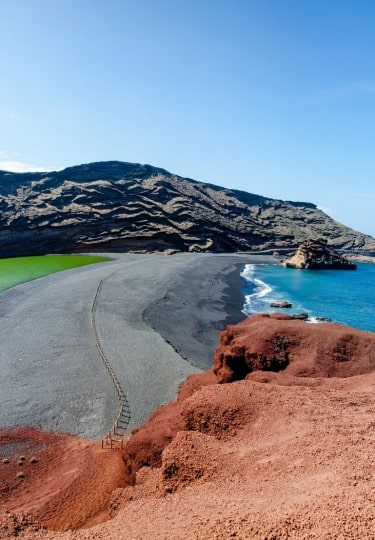There’s something captivating about a black sand beach. The sea seems a deeper shade of sapphire and the sand sparkles thanks to the high mineral content of volcanic matter.
Black sand beaches are located all over the world, from the sheer-sided caldera of Santorini in Greece to the geothermal hotspot of the Canary Islands, as well as mountainous Hawaii, lush Tahiti, Japan, and several islands in the Caribbean.
Here are 13 of the most spectacular black sand beaches in the world.
Perivolos Beach, Santorini, Greece
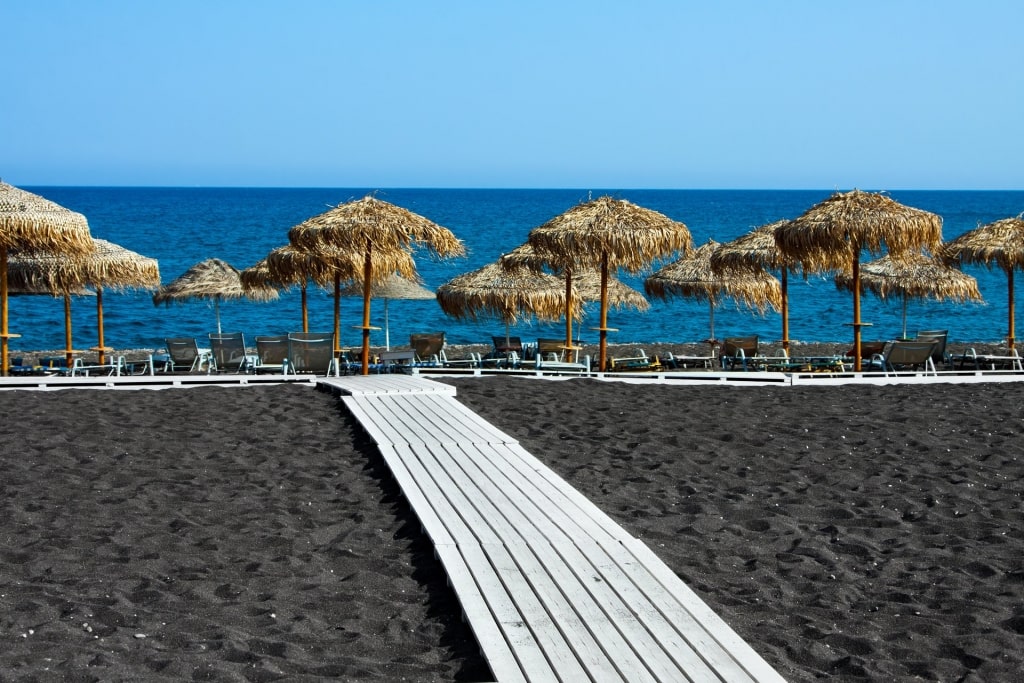
Perivolos Beach in Santorini, Greece
Volcanic Santorini is ringed by sparkling black sand beaches, but Perivolos, in the south of the crescent-shaped island, is the longest. It’s also one of the most organized, with thatched umbrellas, watersports concessions and waterfront tavernas selling fresh seafood for lunch.
The nearest town is Perissa, served by Santorini’s efficient local bus service, and from there, you can stroll the very scenic couple of miles along the seashore to Perivolos.
Read: Best Beaches in Greece
Taharuu Beach, Papeete, Tahiti
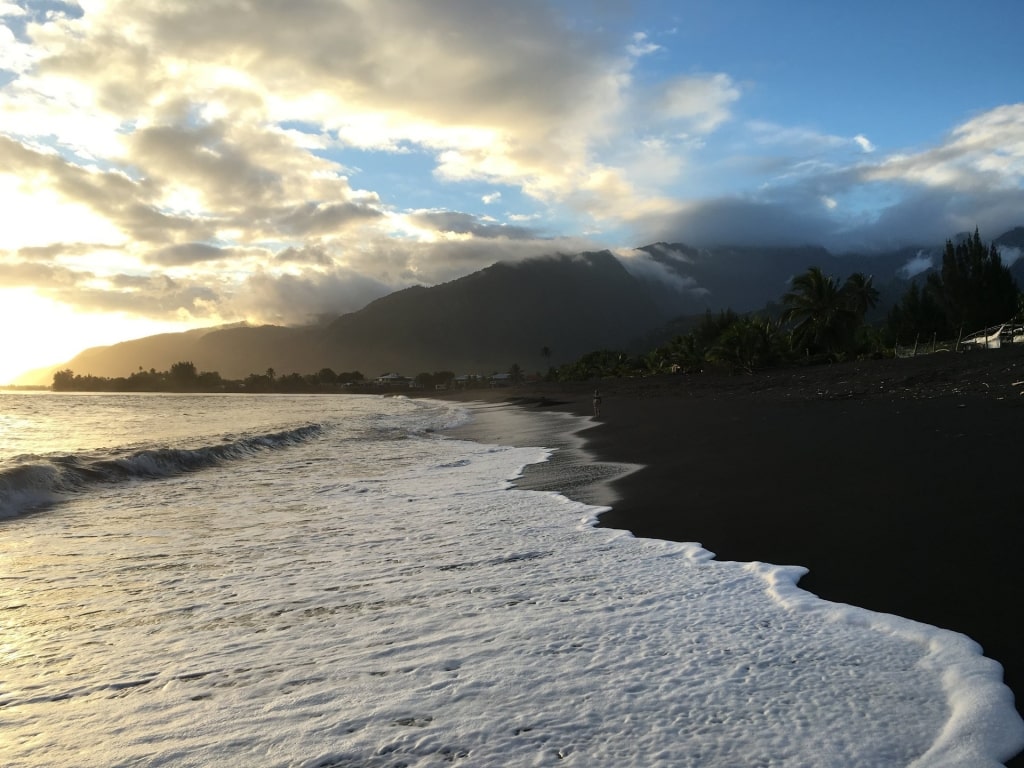
Taharuu Beach in Papeete, Tahiti
Some 25 miles southeast of Papeete, in Papara, Taharuu Beach is the real thing: a wide sweep of jet black sand, glossy green palms and deep blue sea. Swimming here is safe, although there are decent enough waves for surfers to hone their skills.
You’ll see a lot of locals here, as well as visitors. A small beach shack serves snacks, but you should bring your own water. It’s very easy to lose track of time at Taharuu, splashing in the warm water, taking in the natural beauty and watching the surfers.
Reynisfjara Beach, Iceland
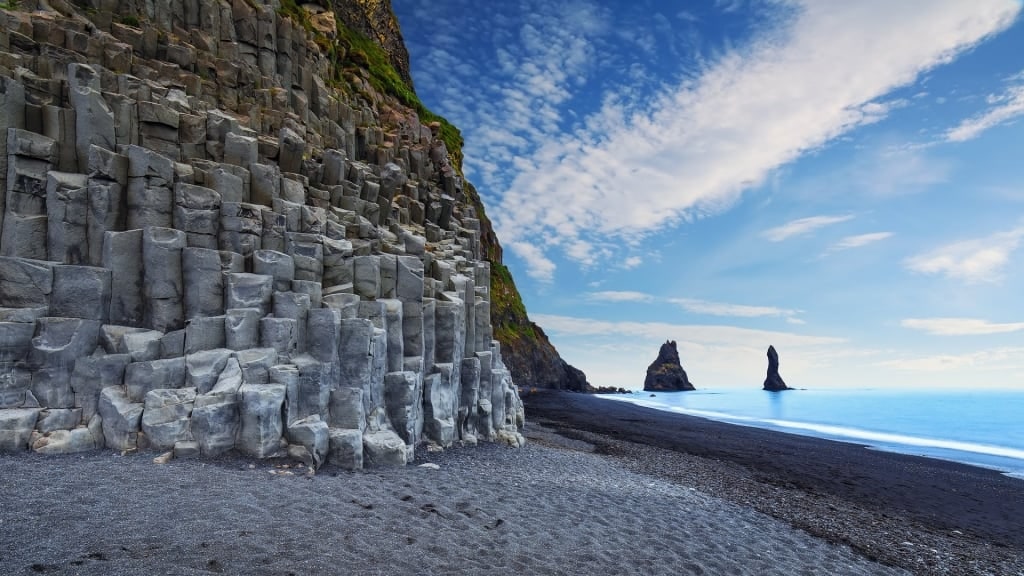
Reynisfjara Beach, Iceland
You certainly won’t be visiting Iceland’s dramatic black sand beaches to swim, but the coastal scenery is jaw-droppingly spectacular. If you’ve already explored Reykjavik and done the Golden Circle, consider a day trip to dazzling Reynisfjara, two hours’ drive from the capital across stark, treeless landscapes of black lava. The journey itself is part of the attraction.
At Reynisfjara, basalt sea stacks pointed like witches’ hats jut out of the sea, believed in local lore to be trolls turned to stone while dragging a ship to shore. The Icelandic beach itself is a vast expanse of glittering black sand. The whistling wind and the crashing of rollers on the shore create an eerie, otherworldly sound, and you may well have the place to yourself.
Playa Jardin, Tenerife, Canary Islands
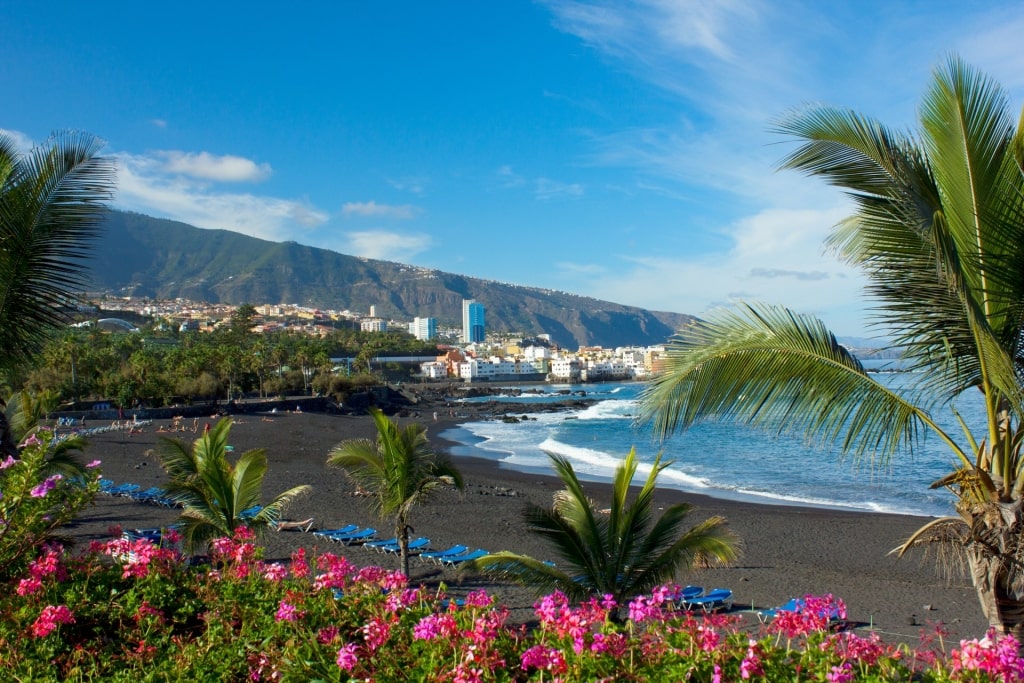
Playa Jardin in Tenerife, Canary Islands
Playa Jardin is part of a stylish complex of urban black sand beaches and gardens in Tenerife designed in the 1990s by legendary Spanish architect César Manrique. The beach is actually artificial, although you wouldn’t know by looking at it; the black sand has been dredged from the seabed.
This Canary Island beach is located in the upscale resort town of Puerto de la Cruz on the island’s west coast. There are three sections, divided by breakwaters to keep the biggest Atlantic rollers at bay, but leaving enough surf to attract anybody wanting to test the waves.
Kids’ playgrounds, cafés, subtropical gardens and the looming peak of mighty Teide, Spain’s highest mountain, create a pleasant setting. If Teide is wearing its snowy cap, the scenery is all the more dramatic.
Read: Best Beaches in Tenerife
Punalu’u Beach, Hawaii
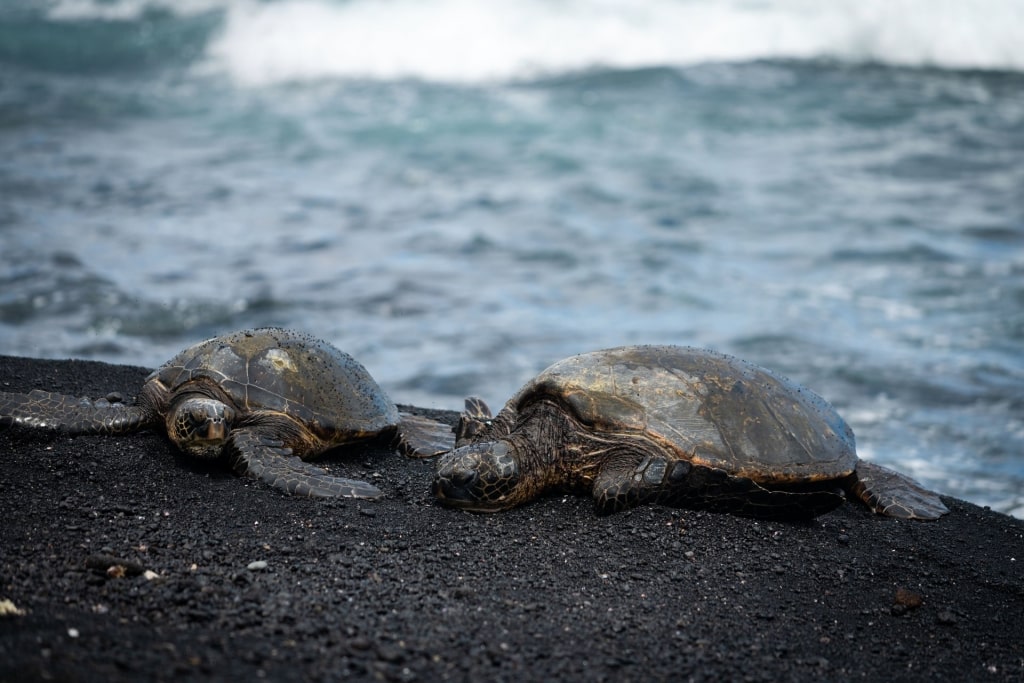
Punalu’u Beach, Hawaii
Fringing the southeastern coast of the Big Island of Hawaii, Punalu’u is one of Hawaii’s most striking black sand beaches. Tall coconut palms arch over jet black sand, where protected green sea turtles nest. This is more of a beach for simply taking in the view and enjoying a picnic than for swimming, as the currents can be strong, but it’s certainly extraordinary to look at.
If you do venture into the water, be prepared for a strange sensation. Freshwater springs bubble up under the seafloor here and the cold water rises to the surface, so you could find yourself swimming in water that is alternately warm and bracingly cold.
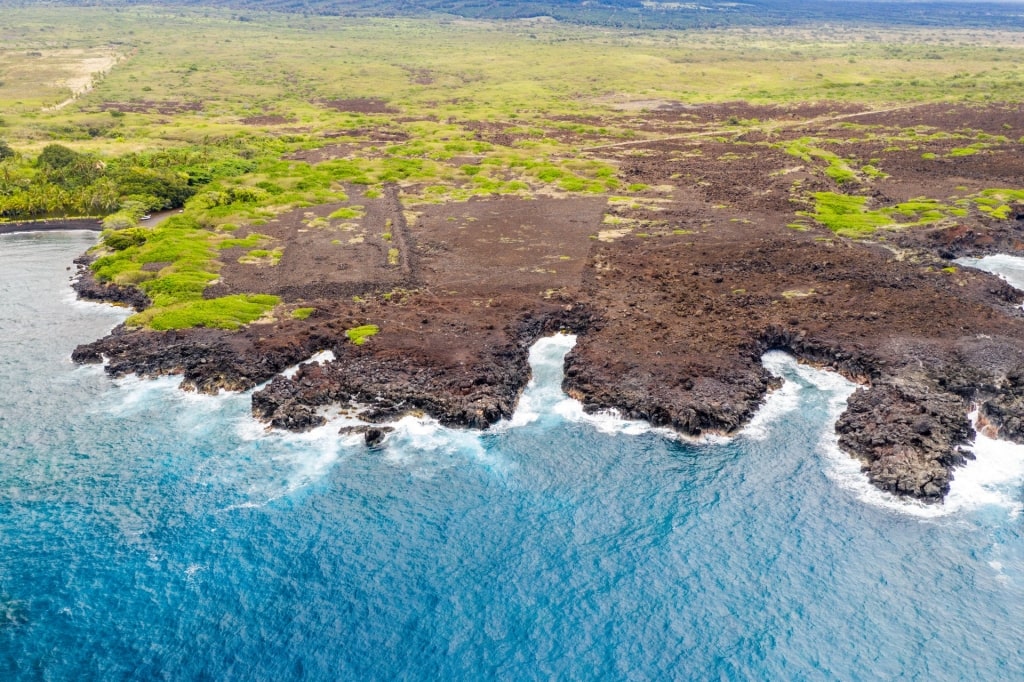
Punalu’u Beach, Hawaii
Like all the black sand beaches on Hawaii, Punalu’u is protected and you’re not allowed to take any sand. Black sand beaches are often fragile, in geological terms. Because they’re created by volcanic eruptions, which may only occur once every few centuries, there’s little to replenish the sand if a storm sweeps it away, unlike, say, coral sand beaches, which are restocked by nature on a continual basis.
Mero Beach, Roseau, Dominica
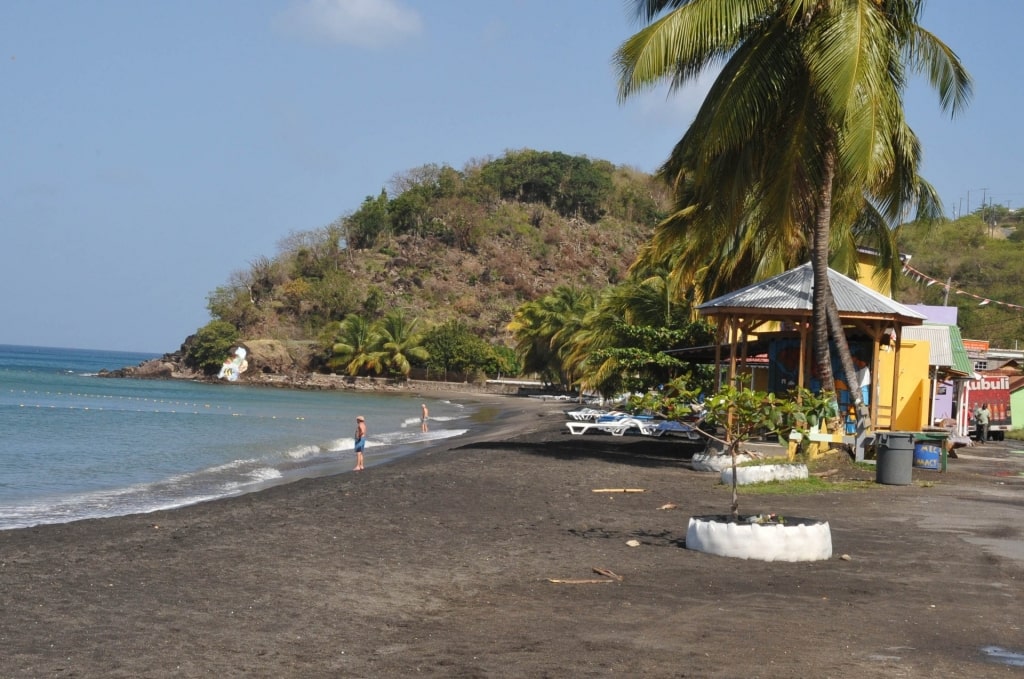
Mero Beach in Roseau, Dominica Photo by Jerrye & Roy Klotz, MD on Wikimedia Commons, licensed under CC BY-SA 3.0
Volcanic Dominica is wild and untamed by Caribbean standards, with mountainous, jungly scenery and sparkling beaches, some in shades of silvery gray. Mero, just half an hour from Roseau, the island’s capital, is a favorite with locals who descend on the beach on weekends for barbecues and swimming in the warm, shallow water.
Generally, though, this is a peaceful spot in Dominica, with a few beach bars and restaurants nearby to make a day of it with a laid-back, toes-in-the-sand lunch.
Senggigi Beach, Lombok, Indonesia
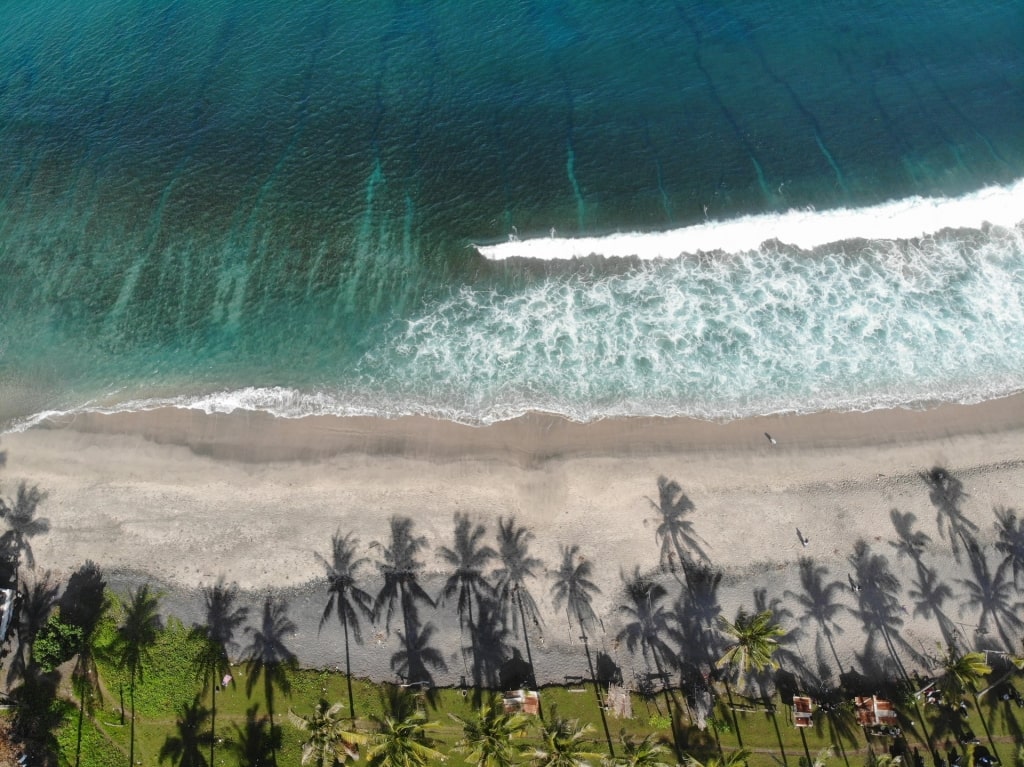
Senggigi Beach in Lombok, Indonesia
Hugging the mountainous northwest coast of Lombok, Senggigi is a popular strip of black and gold sand, a product of the many eruptions of Mount Rinjani which looms in the distance.
The beach is lined with hotels and restaurants, with more places to explore set just inland. Clear water means there’s good snorkeling here, while there’s no shortage of activities, from stand-up paddleboarding to sea kayaking.
Read: Best Beaches in Bali
Miho-no-Matsubara, Shizuoka City, Japan
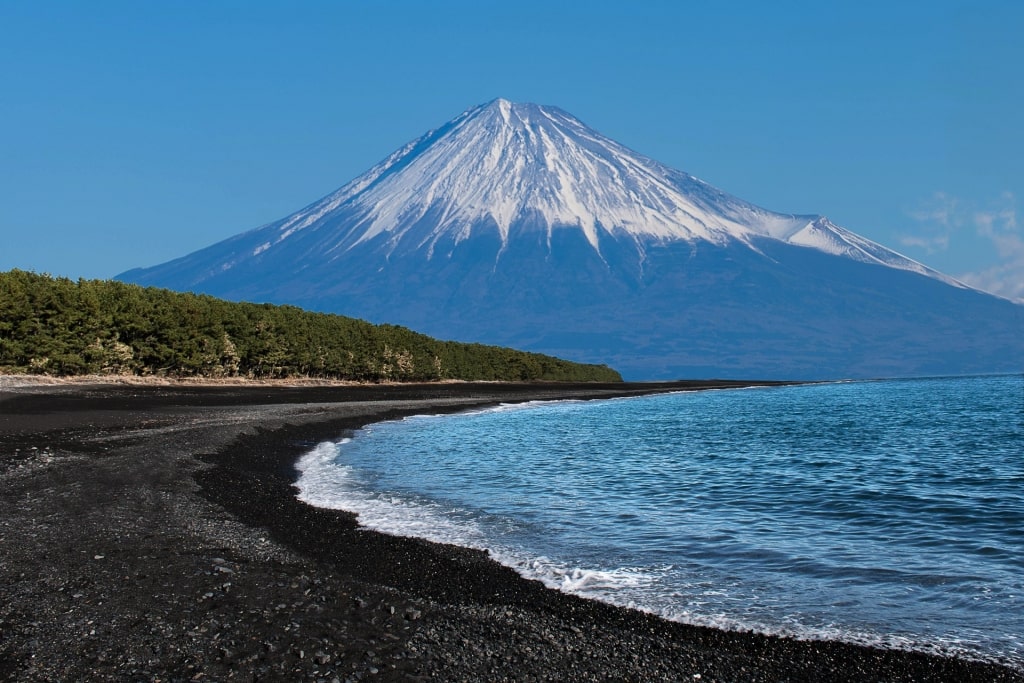
Miho-no-Matsubara in Shizuoka City, Japan
Miho-no-Matsubara is a mesmerizing sight. A dense pine forest of more than 54,000 trees spills onto a beach of jet black sand, four miles long, the conical, snow-capped dome of Mount Fuji towering in the background. Little wonder that this beautiful and unusual beach has inspired writers and poets.
The Miho peninsula, an easy train ride from Tokyo, is popular in summer for windsurfing, diving, fishing and swimming. You can also rent a bicycle and cycle around the peninsula, or stroll through the scented shade of the pine woods.
Read: Best Beaches in Japan
El Golfo, Lanzarote, Canary Islands
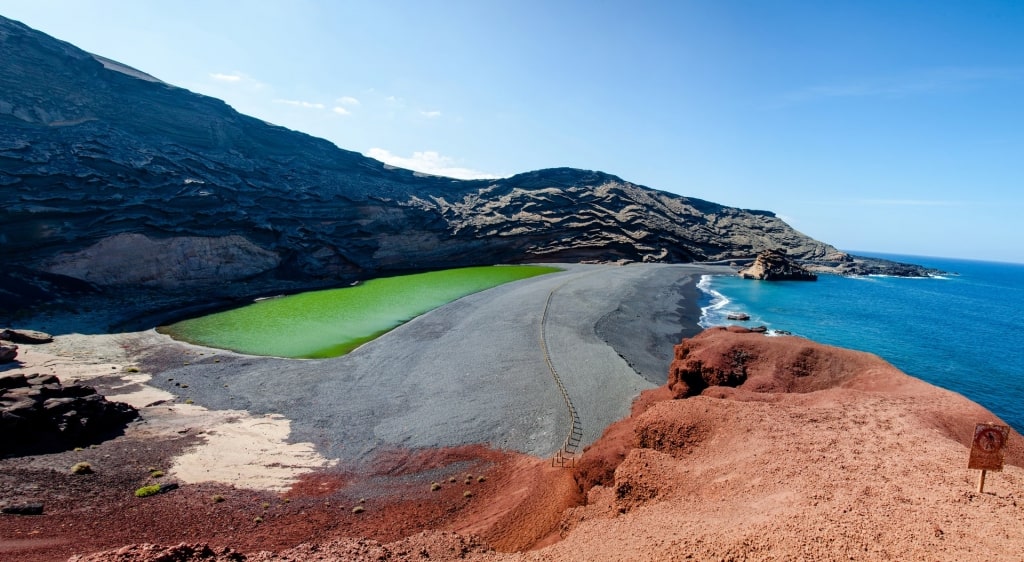
El Golfo in Lanzarote, Canary Islands
If anywhere sums up the sheer otherworldliness of volcanic Lanzarote, it’s this jet black beach, hemmed in by the eroded semicircle of an ancient volcano.
At the center of what was once the caldera, separated from the pounding waves by low black dunes, there’s an emerald-green lagoon, Lago Verde. The lagoon gets its bright green color from a type of phytoplankton that thrives on seawater that’s filtered through the volcanic material.
Neither the lagoon nor the wild Atlantic rollers are exactly inviting for swimming, but there’s no question that El Golfo is one of the most photogenic spots on this extraordinary island. Numerous movies and commercials have been shot here, and visiting is one of the best things to do in Lanzarote.
There are no facilities, which is all part of the setting’s charm, but after admiring the black-and-red layered cliffs, the lagoon and the sparkling beach, head for the village of El Golfo itself, where you’ll find plenty of decent seafood restaurants.
Kamari Beach, Santorini, Greece
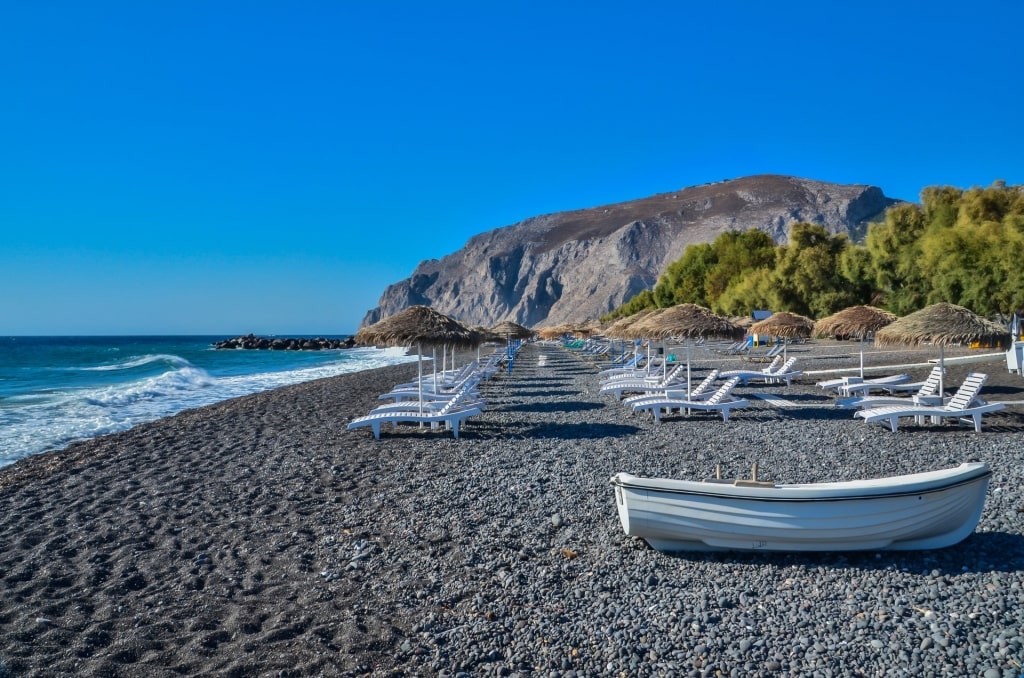
Kamari Beach in Santorini, Greece
Stretching along the eastern shore of Santorini, Kamari Beach is composed of black, pebbly sand; like all the black sand beaches on the island, much of this material would have originated in the cataclysmic eruption that changed the shape of the island in the 17th century B.C.
One of the best beaches in Santorini, its stark beauty is overlooked by the hulking Mesa Vouno mountain. It’s lined by bars, shops and tavernas in the characteristic Cycladean style of brilliant white with splashes of sky blue.
Kamari today is a family spot by day and something of a party place in the evenings, where DJs spin tunes as the sun begins to set. If the heat becomes too intense while you’re sunbathing, take a stroll into the shaded back alleys of the resort where you can take refuge in cool, quirky boutiques or relax in the shade of a bar with an ice-cold Mythos beer.a
Anse Couleuvre, Saint-Pierre, Martinique
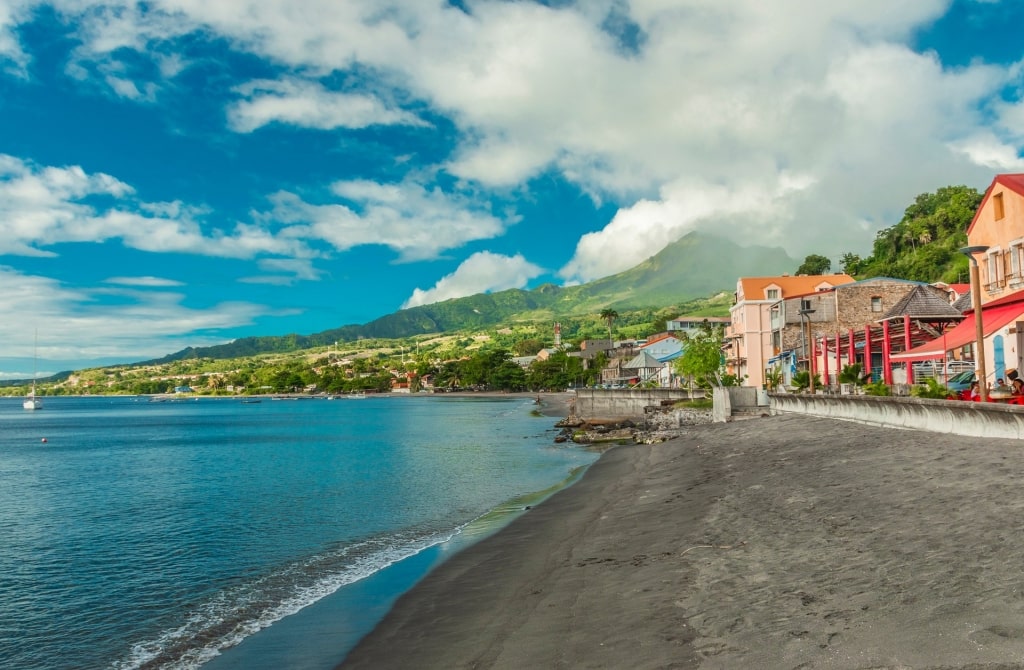
Anse Couleuvre in Saint-Pierre, Martinique
Martinique is dominated by the 4,503-foot peak of Mont Pelée, an active volcano. As such, many of the island’s beaches are composed of black sand. The town of Saint-Pierre de la Martinique has an uneasy relationship with the mountain, having been almost totally destroyed by a massive eruption in 1902.
The pretty little town itself, now rebuilt, is fronted by a black sand beach, but there’s an even better treat just to the north. Here, Anse Couleuvre has to be one of the most beautiful stretches of sand on the island.
Dense vegetation plunges to the water’s edge, the beach itself a little half-moon of sand shaded by coconut palms. Just over an hour from Fort-de-France, it’s not easy to find. The last section of the journey is done on foot once the road runs out, but the reward is a pristine stretch of often deserted sand.
Karekare Beach, Auckland, New Zealand
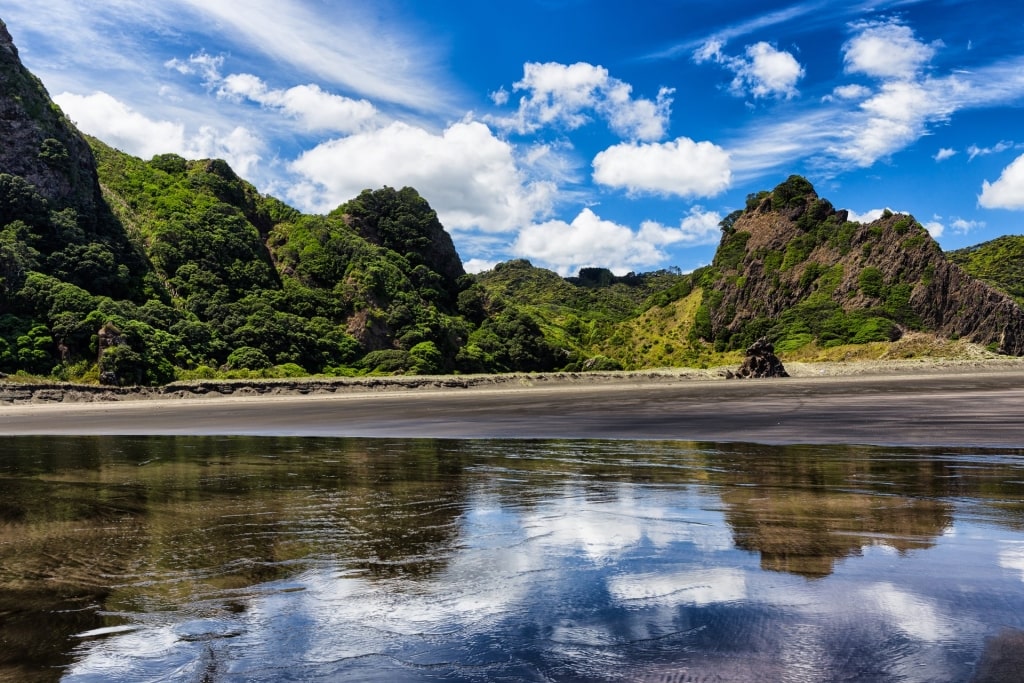
Karekare Beach in Auckland, New Zealand
The glittering black sands of Karekare Beach are only a 50-minute drive from Auckland, with the added bonus of a tumbling waterfall a 15-minute stroll from the beach. You can cool off in the rock pool at the base of the falls after the walk, or relax in the shade there.
This New Zealand beach is a wide expanse of sparkling black sand, pounded by tumbling waves and backed by black cliffs and low-lying dunes, on which you’ll see locals sand surfing. Bring a picnic for your visit here; this is a wild, remote spot without facilities.
Read: Best Beaches in Auckland
Black Sands Beach, Sausalito, California
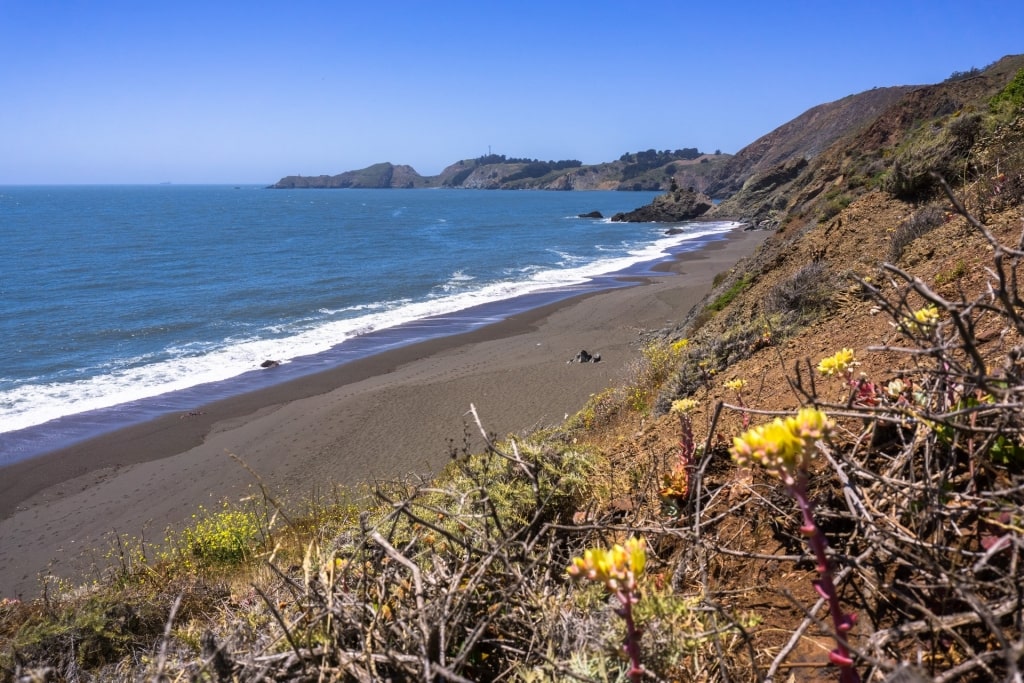
Black Sands Beach in Sausalito, California
Across the Golden Gate Bridge, beneath the Marin Headlands, you’ll find one of the only black sand beaches in the continental U.S. Black Sands Beach is a narrow strip of sand at the base of sheer cliffs, which is even more dramatic-looking and narrower at high tide, so do check the tide timetables before you make the journey.
You’re here for the novelty rather than the swimming, as strong currents and pounding surf make swimming dangerous. Be aware, too, that one end of the beach is clothing optional.
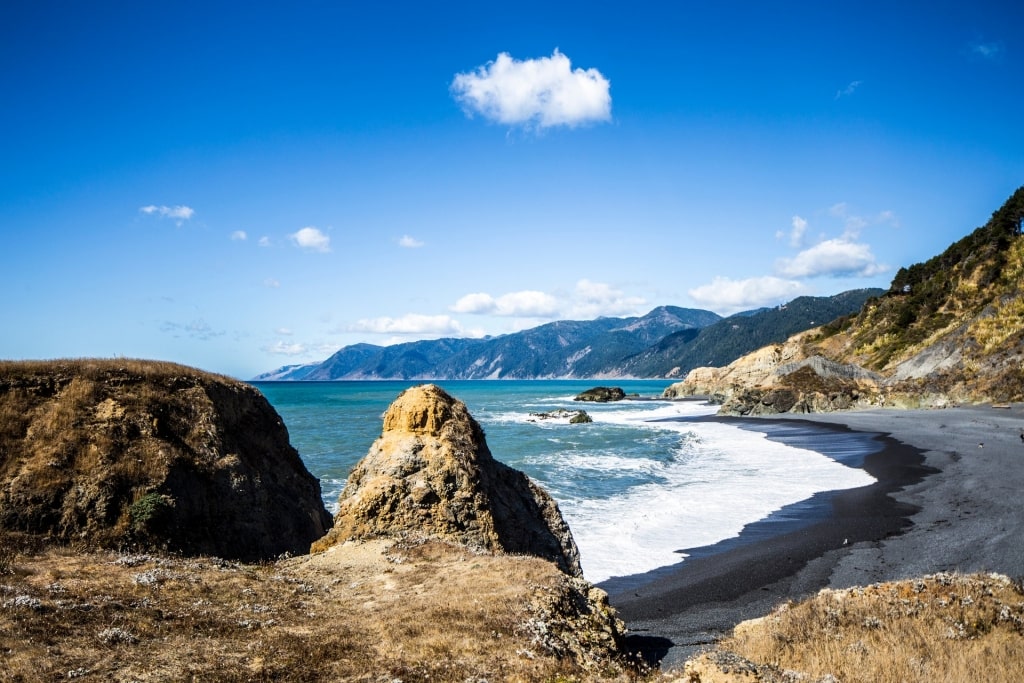
Black Sands Beach in Sausalito, California
What causes black sand beaches?
Black sand beaches are created by the gradual erosion of lava and other volcanic materials, most of which are black or dark in color. The high mineral content of black sand may give it an alluring sparkle, while the presence of iron gives the sand a dense, heavy texture.
Can you swim in black sand beaches?
Black sand beaches are as enticing as beaches of any other color for swimming, provided the conditions are safe. If you’re perched on the edge of a volcano that plunges into the sea, beware of steep drop-offs, for example.
Also bear in mind that black sand absorbs solar radiation more effectively than pale sand. You’ll usually need sandshoes to walk from your beach chair to the water’s edge as black sand can get extremely hot.
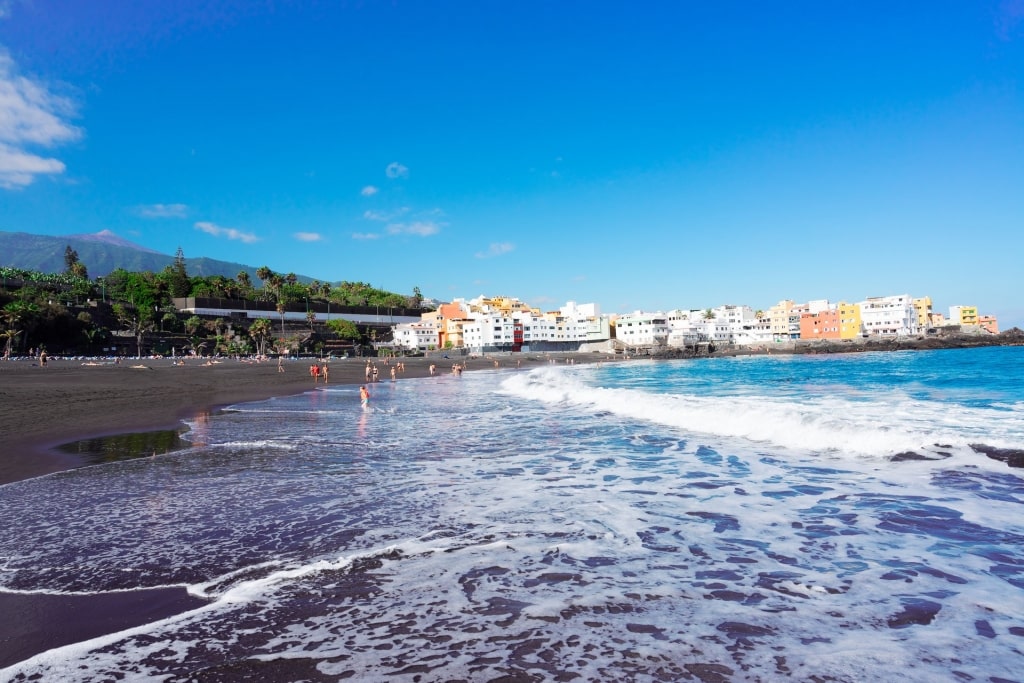
Playa Jardin in Tenerife, Canary Islands
Ready to seek out some of the most dazzling beaches in the world? Browse our itineraries and plan your next cruise.
